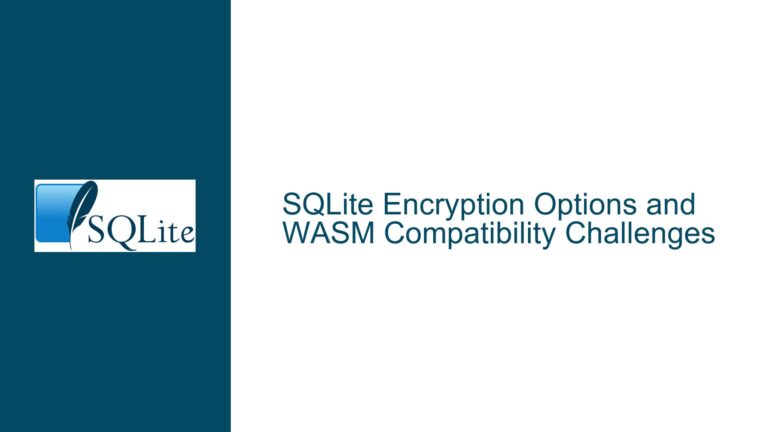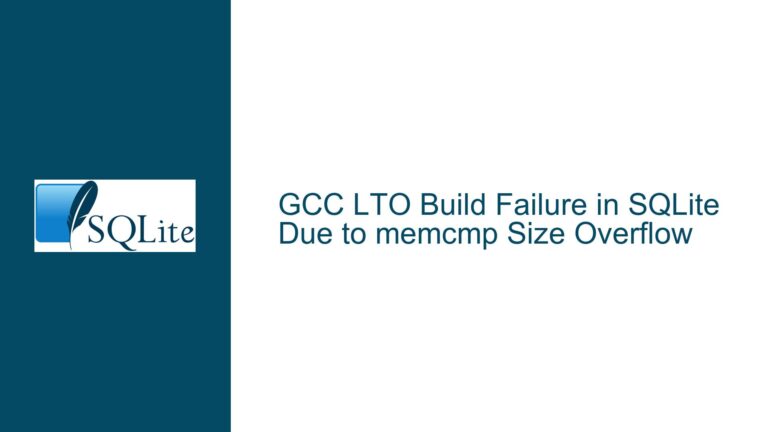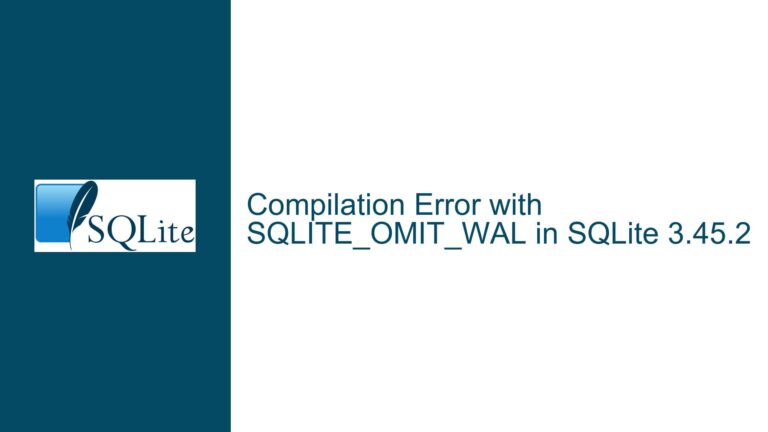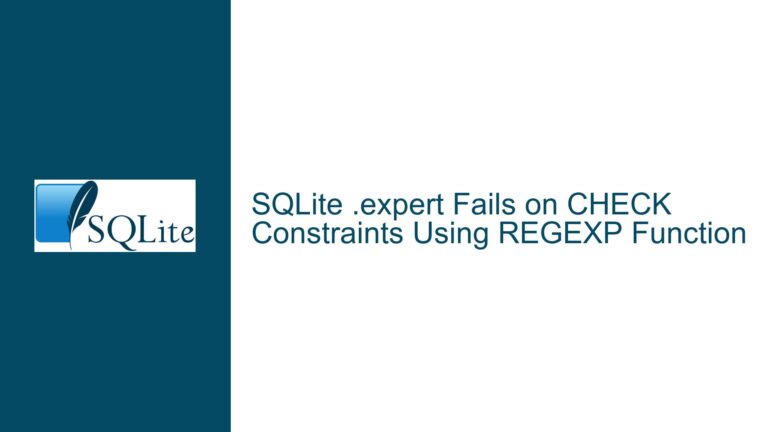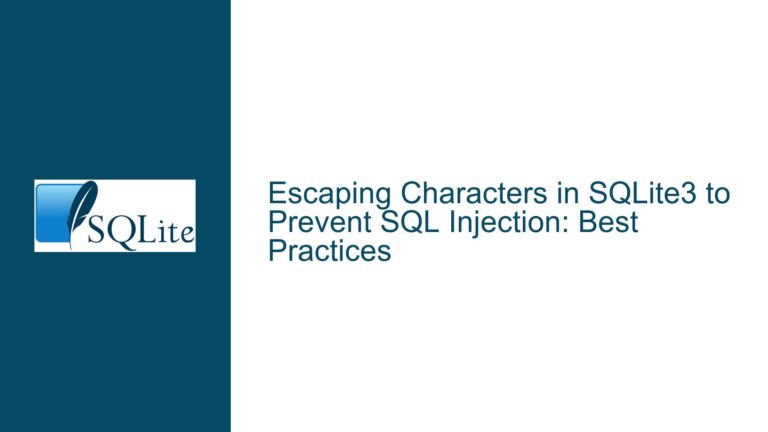Unexpected Data Overwrite from sqlite_master into Application Table
Unexpected Corruption of Application Table Data with sqlite_master Entries
The core issue involves an unexpected overwrite of the first 31 entries in an application-specific settings table with data from the sqlite_master system table. This occurred in a SQLite database deployed on a Windows CE 13 device using the System.Data.SQLite library. The database employs both manual VACUUM operations (triggered every 10th device startup) and auto-vacuum settings. The device experienced a sudden power loss, though SQLite’s journaling mechanism should theoretically prevent corruption. The sqlite_master table is not directly referenced in the application code, and no manual database modifications were performed. The overwrite event raises critical questions about SQLite’s internal behavior under specific operational conditions, particularly when maintenance routines like VACUUM interact with transaction boundaries, storage hardware limitations, and environmental instability.
To understand this anomaly, we must dissect the roles of SQLite’s internal structures. The sqlite_master table is a schema metadata repository containing entries for tables, indices, triggers, and views. It is not designed to be directly modified by user applications. Any unintended interaction between this system table and application data tables suggests a deep-seated issue in SQLite’s transaction management, storage layer integrity, or memory safety during maintenance operations. The settings table in question stores configuration data, with a counter updated after each VACUUM operation. The automatic execution of VACUUM while the database is open—and potentially mid-transaction—creates a precarious scenario where schema reorganization might inadvertently expose or corrupt memory buffers shared between SQLite’s internal operations and application data.
The problem is exacerbated by the deployment environment: Windows CE 13 is a constrained operating system often used in embedded devices with limited computational resources. Such environments are prone to abrupt power cycles, suboptimal storage media (e.g., NAND flash with wear-leveling quirks), and reduced fault tolerance for file system operations. SQLite’s robustness in these contexts depends heavily on proper configuration of journal modes, synchronous writes, and transaction isolation. The interplay between frequent VACUUM operations, auto-vacuum’s background space reclamation, and power-loss resilience mechanisms forms a complex matrix where a single misconfiguration or hardware glitch can cascade into data corruption.
Potential Triggers: VACUUM Execution Context, Memory Corruption, and Storage Layer Instability
1. VACUUM Operation Boundary Conditions and Transaction Isolation
The VACUUM command rebuilds the entire database file to defragment storage, reclaim free pages, and reset row IDs. This process requires exclusive access to the database and temporarily creates a new file, copying data from the original. Crucially, VACUUM is not transactional—it cannot be rolled back if interrupted. In this case, the application executes VACUUM automatically after every 10th device startup, while the database is already open for counter updates in the settings table. If the VACUUM operation overlaps with active transactions or read/write operations on the settings table, SQLite’s internal page cache or buffer management could cross-contaminate data between the sqlite_master schema pages and application data pages.
Windows CE’s file system semantics may further complicate this. If the OS delays or reorders write operations—especially on removable or flash-based storage—the temporary file created by VACUUM might not atomically replace the original database. A power failure during this critical phase could leave the database in a state where partially written pages from the sqlite_master table are incorrectly mapped to the settings table. This risk is heightened if the VACUUM operation is initiated without ensuring all prior transactions are fully committed and the database connection is in a clean state.
2. Memory Safety Violations in SQLite or System.Data.SQLite
SQLite is designed to be resilient to memory allocation errors and buffer overflows, but it is not immune to bugs in client code or underlying libraries. The System.Data.SQLite adapter, which interfaces the native SQLite engine with .NET applications, could introduce memory management issues—especially if the application binds parameters improperly, reuses prepared statements without resetting them, or mishandles BLOB data. A subtle bug in the adapter might cause SQLite’s internal buffers (holding sqlite_master data) to be erroneously written to the settings table during cursor operations or page flushes.
For example, if a buffer intended for schema metadata is incorrectly associated with a user table’s cursor due to a pointer arithmetic error, subsequent writes to the settings table could overwrite the buffer’s contents. Such issues are notoriously difficult to reproduce but are more likely in environments with constrained memory or custom memory allocators. The Windows CE runtime might employ memory optimization strategies that inadvertently expose latent bugs in SQLite or its adapter.
3. Flash Storage Characteristics and Journaling Limitations
Embedded devices frequently use NAND flash storage, which has unique constraints: write operations occur in blocks, erase cycles are slow, and wear-leveling algorithms remap physical sectors transparently. SQLite’s write-ahead logging (WAL) or rollback journal rely on the storage medium honoring fsync() calls to ensure writes are durable and ordered. On flash-based systems, particularly those with poorly implemented drivers, the journal might not be flushed correctly before a power loss. If the journal is incomplete or out-of-sync with the database file, a recovery process could replay incorrect page changes, including those involving sqlite_master.
Moreover, auto-vacuum mode (enabled via PRAGMA auto_vacuum=1) operates differently from manual VACUUM. Auto-vacuum merely truncates the database file when transactions commit, whereas VACUUM rebuilds the entire file. If both mechanisms are active, they might interfere with each other’s free page management, leading to metadata inconsistencies. A power failure during an auto-vacuum truncation could corrupt the internal freelist, causing SQLite to misinterpret page allocations and overwrite user data with schema pages during subsequent operations.
Mitigation Strategies: Isolating VACUUM, Validating Memory Safety, and Hardening Storage
1. Re-architecting VACUUM Execution and Transaction Flow
Immediate Action: Disable automatic VACUUM execution until the root cause is identified. Replace it with periodic manual execution during maintenance windows.
Code Modifications:
- Ensure VACUUM is executed in a dedicated database connection with no overlapping transactions. Before invoking VACUUM, close all other connections and guarantee no prepared statements are active.
- Wrap the VACUUM operation in a procedural check:
BEGIN EXCLUSIVE; VACUUM; COMMIT;While VACUUM itself is not transactional, the
BEGIN EXCLUSIVEforces a clean state by blocking other writers.
Configuration Adjustments:
- Set
PRAGMA journal_mode=TRUNCATE(if using rollback journal) orPRAGMA journal_mode=WALto enhance crash resilience. On Windows CE, test both modes under power-loss simulations. - Increase the
PRAGMA synchronoussetting toFULLto ensure writes are fully flushed to storage, even at the cost of performance.
2. Diagnosing Memory Corruption and Adapter Bugs
Tooling:
- Instrument the application with memory debuggers (e.g., Valgrind, although Windows CE compatibility is limited) to detect buffer overflows, dangling pointers, or double-free errors in System.Data.SQLite.
- Enable SQLite’s internal integrity checks using
PRAGMA integrity_checkandPRAGMA quick_checkafter each VACUUM operation to detect early signs of corruption.
Code Audits:
- Review all uses of
SQLiteCommandobjects, ensuring parameters are explicitly bound (avoid string concatenation) and thatDispose()is called promptly to release native resources. - Verify that
SQLiteDataReaderinstances are closed immediately after use, preventing cursor leaks that might hold stale references to schema data.
Fallback Strategies:
- If memory corruption is suspected, switch to a statically linked SQLite build with debugging symbols. Monitor for assertion failures or error logs indicating invalid page IDs or schema mismatches.
3. Hardening Against Storage Layer Failures
Hardware Checks:
- Perform a full scan of the device’s flash storage for bad blocks using manufacturer-specific tools. Remap or retire faulty sectors.
- Ensure the file system is mounted with
noatimeand other options to minimize write amplification on flash memory.
Operational Safeguards:
- Deploy uninterruptible power supplies (UPS) or supercapacitors to allow graceful shutdowns during power loss.
- Implement a watchdog timer that triggers a controlled database closure if the application hangs during VACUUM.
Backup and Recovery:
- Schedule regular offline backups before high-risk operations like VACUUM. Use SQLite’s
.dumpcommand to generate a SQL script, which is less prone to binary corruption. - Develop a recovery protocol that restores the settings table from a backup if corruption is detected, cross-referencing with transaction logs to minimize data loss.
Long-Term Monitoring:
- Log all VACUUM operations, including start/end timestamps and database file sizes. Correlate these logs with power cycles to identify patterns.
- Enable SQLite’s
sqlite3_trace_v2()API to capture low-level query execution and page access sequences, aiding forensic analysis after a corruption event.
By systematically addressing the interaction between VACUUM, transaction boundaries, memory management, and storage reliability, developers can mitigate the risk of schema-data cross-contamination. This requires a holistic approach combining code hygiene, configuration tuning, and environmental hardening—particularly in embedded systems where SQLite’s “serverless” architecture is both a strength and a vulnerability.

